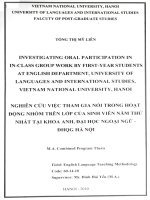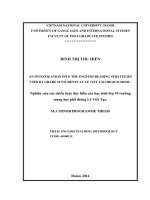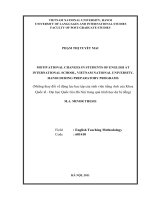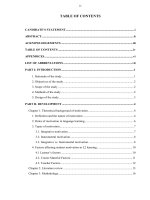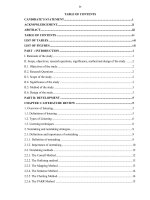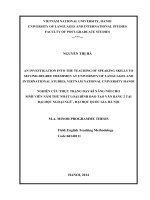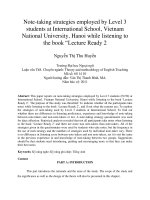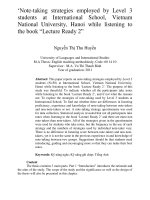Note-taking strategies employed by level 3 students at International School, Vietnam National University, Hanoi while listening to the book Lecture Ready 2 Các.PDF
Bạn đang xem bản rút gọn của tài liệu. Xem và tải ngay bản đầy đủ của tài liệu tại đây (811.57 KB, 45 trang )
iv
TABLE OF CONTENTS
CANDIDATE’S STATEMENT i
ACKNOWLEDGEMENT ii
ABSTRACT iii
TABLE OF CONTENTS iv
LIST OF TABLES vii
LIST OF FIGURES vii
PART : INTRODUCTION 1
I. Rationale of the study 1
II. Scope, objectives, research questions, significance, method and design of the study 2
II.1. Objectives of the study 2
II.2. Research Questions 2
II.3. Scope of the study 2
II.4. Significance of the study 3
II.5. Method of the study 3
II.6. Design of the study 3
PART B: DEVELOPMENT 5
CHAPTER 1: LITERATURE REVIEW 5
1. Overview of listening 5
1.1. Definitions of listening 5
1.2. Types of Listening 6
1.3. Listening techniques 8
2. Notetaking and notetaking strategies 9
2.1. Definitions and importance of notetaking 9
2.1.1. Definition of notetaking 9
2.1.2. Importance of notetaking 10
2.2. Notetaking methods 12
2.2.1. The Cornell Method 12
2.2.2. The Outlining method 13
2.2.3. The Mapping Method 13
2.2.4. The Sentence Method 14
2.2.5. The Charting Method 14
2.2.6. The PARR Method 15
v
2.3. Previous studies on note-taking strategies 16
CHAPTER 2: METHODOLOGY 19
2.1 Research questions 19
2.2. Participants and settings of the study 19
2.2.1. Participants 19
2.2.1. Settings of the study 20
2.3. Data collection instruments 20
2.4. Data collection procedure 21
2.5. Data analysis procedure 22
CHAPTER 3: FINDINGS 23
3.1. Numbers of note-takers and the reasons for not taking notes 23
3.1.1. Number of note-takers 23
3.1.2. Reasons for not taking notes 24
3.2. Students’ personal information and background knowledge of note-taking 25
3.2.1. Student’s personal information 25
3.2.2. Student’s background knowledge of note-taking 26
3.3. Note-taking strategies employed by Level 3 students at International School 28
3.4. Differences in Listening Proficiency, note-taking experience and note-taking knowledge
between note-takers and non-note-takers 30
3.4.1. Differences in Listening proficiency and note-taking experience between note-takers
and non-note-takers 31
3.4.2. Differences in knowledge of note-taking between note-takers and non-note-takers 31
CHAPTER 4: ANALYSIS AND DISCUSSION 33
4.1. Reasons for not taking notes 33
4.2. Note-taking strategies use by Level 3 students at International School 34
4.3. Note- takers vs. non note- takers 35
4.3.1. Differences in listening comprehension and previous experience of note-taking 36
4.3.2. Differences in note-taking knowledge 37
PART C: CONCLUSION 39
1. Summary and Implications 39
2. Limitations and suggestions for further study 40
REFERENCES
APPENDIX
vi
LIST OF TABLES
Table 1: Sections in the questionnaires 21
Table 2: Number of note-taking strategies used by individual note-takers 30
Table 3: Number of notetakers and non-notetakers in terms of listening proficiency and
notetaking experience 31
Table 4: Number of notetakers and non-notetakers in terms of notetaking knowledge 32
LIST OF FIGURES
Figure 1: Percentage of note-takers 23
Figure 2: Reasons for not taking notes 24
Figure 3: Percentage of students’ English Listening Score 25
Figure 4: Percentage of students being taught to take notes before 25
Figure 5: Percentage of student’s opinion on note-taking definition 26
Figure 6: Percentage of student’s opinion on the order of note-taking activities 27
Figure 7: Strategies employed by note-takers 28
1
PART A: INTRODUCTION
This part introduces the rationale and the aims of the study. The scope of the study and
the significance as well as the design of the thesis will also be presented in this chapter.
I. Rationale
Listening to an English lecture has long been a difficult task to Vietnamese university
students who hardly had any chances to practice listening skills at lower- level schools. Note-
taking has long been considered an integral part of effective listening. Note-taking while
listening is considered one of the most important skills which language learners should master,
particularly as it helps to develop a sense of listening, allowing the reader to recognize main
ideas and to understand the organization of the material. Note-taking is believed to be an
important part of all of our learning interactions, from the most traditional, structured
experiences to highly informal, unstructured situations.‟ This is extremely significant for
Vietnamese learners who have been studying English listening skills traditionally in non -
native environment, and have just started to learn listening in communicative way.
But acquiring and mastering note-taking is likely to become a big hindrance to many
learners while they often find it difficult to exploit this skill in their learning experience. It is
especially true for General English students at International School, Vietnam National
University, Hanoi, whose English level are not very high. There are many reasons behind this
phenomenon. Students can be neither paying attention, nor write quickly enough. It can be due
to the fact that their spelling is not good enough or they cannot understand the teachers.
Sometimes, the lectures are in a too high level for their capabilities. However, the most
common reason may be students‟ shortage of note-taking strategies to use flexibly in listening
to different lectures.
Therefore, the question of how to equip students with note-taking strategies so that
they can use the skill to support foreign language listening in any situation has become a
matter of teachers of English in general and teachers of English at International School in
particular.
In Vietnam, there has so far been some research on note-taking strategies. However,
research on note-taking strategies employed by students at International School, VNU has not
been done yet.
2
As a teacher of English, I have dealt with many questions relating to note-taking which
are raised by my students or among my colleagues. For example, what are the effective ways
of taking notes? How to note down important information? Personally I found it necessary to
provide to them successful note-taking strategies to listen to the lecture. This is the major
reason why this topic interests me.
II. Scope, objectives, research questions, significance, method and design of the study
II.1. Objectives of the study
The objectives of the study are as follows:
- To indicate whether all the participants take notes while listening to the book „Lecture Ready
2‟, and if not what the reasons are.
- To explore the strategies of note-taking used by Level 3 students at International School.
- To find out whether there are differences in listening proficiency, experience and knowledge
of note-taking between note-takers and non-note-takers or not.
II.2. Research Questions
The study set out to seek answers to the following research questions:
♦ Do Level 3 students at International school take notes while listening to the book „Lecture
Ready 2‟? If not, what are the reasons?
♦ What are note-taking strategies employed by Level 3 students at International School?
♦ Are there any differences in listening proficiency, experience and knowledge of note-taking
between note-takers and non-note-takers
II.3. The scope of the study
The study is concerned with finding the students‟ note-taking strategies in listening to
the book “Lecture Ready 2”.
As note-taking strategies pointed out by individuals, institutions, and scholars are of a
variety, the present study only focuses on those which are considered to be popular and the
most easily-used by International School students.
II.4. Significance of the study
3
This study plays an important role in the identification of note-taking comprehension
strategies employed by Level 3 students at International School. Also, non-note-takers‟
reasons for not taking notes are identified. Based on the findings, the study will have many
important implications for training Level 3 students of English at International School in
taking notes.
II.5. Methods of the study
In order to achieve the aims of the study mentioned above, the descriptive method is
the main tool for analyzing the data, which is collected from the questionnaire.
After the data is analyzed and discussed, the findings will be showed and some
conclusions will be drawn and some suggestions will be raised in the thesis.
II.6. Design of the study
This thesis consists of three parts:
Part A: is the Introduction, which presents the rationale, the objectives, the research
questions, the scope, the significance, the methods and the design of the study.
Part B: consists of four chapters.
Chapter 1: deals with a theoretical background. It starts with listening in general including
definitions, types and techniques. The next is note-taking and its importance in language
teaching, then an overview of some note-taking methods - their advantages and disadvantages
in applying in the classroom. Last, the previous studies on note-taking strategies are briefly
summarized.
Chapter 2: presents the survey questionnaires. Firstly, there is a description about the present
situation of English listening teaching and learning at International School. Secondly, the
methodology is performed in the study. It provides participants, instruments and data analysis.
Chapter 3: presents the findings.
4
Chapter 4: analyzes and discusses the findings of the study are
Part C: is about the conclusion and suggestions for a further study.
This part has presented an overview of the study which includes the rational for the
study, the aims, the research questions, the scope, the significance as well as the design of the
study. The next chapter will review the relevant literature which provides a theoretical
framework for the study.
PART B: DEVELOPMENT
CHAPTER 1: LITERATURE REVIEW
This chapter provides a brief review of the theory and research into listening in
general and note-taking strategies in particular. It includes the researchers‟ findings relating to
definition, types and techniques of listening; definitions and importance of note taking, note-
taking methods, note-taking strategies and previous studies on note-taking and note-taking
5
strategies. A justification on the basis of the literature review for the note-taking strategies
definitions and framework adopted by the researcher of the present study are also presented.
1. Overview of listening
1.1. Definitions of listening
It is believed that listening is a significant and essential area of development in a native
language and in a second language. Therefore, there have been numerous definitions of
listening (by O‟Malley, Chamost and Kupper (1989); Buck (2001)) which present different
views of scholars towards the concept.
Listening comprehension is viewed theoretically as a process in which individuals focus
on selected aspect of aural input, construct meaning from passages, and relate what they hear
to existing knowledge (O‟Malley, Chamost and Kupper (1989)).
According to Rost (1994), listening is referred to a complex process that enables us to
understand spoken language. Harmer (2001, p197) categorizes listening into receptive skill,
the way in which people extract meaning form the discourse they hear or see.
Buck (2001, p. 31) indicates that listening is an active process of constructing meaning
and this is done by applying knowledge to the incoming sound in which “number of different
types of knowledge are involved: both linguistic knowledge and non-linguistic knowledge”. In
another word, he concluded “comprehension is affected by a wide range of variables, and that
potentially any characteristic of the speaker, the situation or the listener can affect the
comprehension of the message”.
Anderson and Lynch (1988) pointed out that listening is really a receptive skill along
side with reading skills and the role of the listeners is no longer passive but active. After a
period of listening the learners are exposed to be able to talk or write about what they have
heard, that is the objectives of listening comprehension. Moreover, he uses the term “active
model builder” to refer to the listeners‟ language; listeners have to build their own “coherent
interpretation” of the spoken message. Both parts of this term are important. First, it needs to
be coherent both in what we believe has just been said and with what we already know about
the speaker, the context and the word in general. Second, it is an interpretation, in the sense
that it is our version of what the speaker meant, as far as we are able to assess that meaning.
The two authors use the term “mental model” to refer the listener‟s “coherent interpretation”.
6
This emphasizes the active and personal nature of successful listening. The mental model that
we build as a representation of a spoken of a message is the result of our combining the new
information in what we just heard with our previous knowledge and experience.
In short, in order to be successful in listening, it is advisable that “listening
comprehension is not a skill which can be mastered once and for all and than ignored while
other skills are developed. There must be regular practice with increasingly difficult materials”
(Wilga, 1986, p.157).
1.2. Types of listening
There are many different types of listening. We can classify these according to a number
of variables, including listening purposes, the role of the listener and the types of text being
listened to.
Real-life listening
Many students feel a big gap between listening activities in the classroom and actual
situation. This is because most listening materials including dialogues in text books are very
grammar-oriented and controlled in many ways. The speakers often speak with perfectly
controlled speech, voice, tone, accent and correct grammar. Whereas, in real-life conversations
learners encounter various people with different gender, age, accent, speed, voice, tone. There
may be improper grammar usage, incomplete sentences, redundancy, contractions, overlap and
so forth.
Characteristics of real-life listening
In real-life listening, we depend largely on visual information, including speaker‟s facial
expression, posture, movement and appearance. When a listener engages in listening, vocal
massage filters through the short-term memory system first, and at this time the listener
focuses on auditory or visual stimulus and concentration on the message received. Therefore,
visual stimuli play a very important role in listening.
As for Ur (1984), it would seem reasonable to say that classroom practice should usually
incorporate such characteristics of real-life listening as:
We listen for a purpose and with certain expectations,
We make an immediate response to what we hear,
7
We see the person we are listening to,
There are some visual or environmental clues as to the meaning of what is heard.
Stretch of heard discourse come in short chunks.
Most heard discourse is spontaneous and therefore differs from formal spoken
prose in the amount of redundancy, “noise” and colloquialisms, and in its
auditory characters.
Sometimes particular situations may lack one or more of these characteristics. For
example, when watching television we are not normally expected to respond, when listen to a
lecture we may have to hear uninterrupted speech a very long time indeed, but it is very rare
that none of them is present at all
Classroom listening
Class-room listening may be divided into intensive listening and extensive listening.
Intensive listening
Intensive listening is the careful, focused listening to a short passage for detailed
information or full comprehension, for example, listening to a dialogue on the tape to study its
structures, intonation patterns in an English class.
Extensive listening
Extensive listening is freer and more general listening to natural language for general
ideas, not for a particular detail and not necessary under the teacher‟s direct guidance. The
listening passage for extensive listening can be long or short. The language that is used in the
type of listening is often within the students‟ current ability so that they find it pleasing and
interesting when they are listening. With this type of listening, students are not reinforcing a
structure or practicing a grammar point linked to the rest of the course.
To sum up, it is obvious that mastering the nature of real-life classroom can help
teachers as well as learners gain success in teaching and learning listening skill
1.3. Listening techniques
Southern Nazarene University (1999) introduced effective listening techniques, which
are regarded as top five ways to listen to a lecture. They clarified their points by making
comparison between poor listeners and effective listeners.
8
The first and foremost technique is to choose to find the subject useful. They explained
that poor listeners dismiss most lectures as dull and irrelevant. Meanwhile, effective listeners
choose to listen to discover new knowledge.
Their second advice is to concentrate on the words and message, not on the professor's
looks, clothes or delivery. In their opinion, poor listeners notice faults in a lecturer's
appearance or delivery, but effective listeners strive to pick every professor's brain for self-
gain.
Thirdly, the University stated that when students hear something they are not sure to
agree with, they should react slowly and thoughtfully. They gave explanation that in such
situation, poor listeners stop listening to the speaker and start listening to themselves. They
either passively reject what is being said or launch into impassioned rebuttals (to themselves).
However, in such case, effective listeners do not jump to conclusions and then disengage.
Instead, they keep conclusions tentative while getting more information.
The fourth advice is to identify the "big ideas," those fundamental concepts to which
everything else in the lecture is related. The university pointed out that poor listeners listen
only for facts only. They may retain a few of those facts, but the information is usually
garbled. Whereas, effective listeners look for foundational concepts; they grab key ideas and
use them as anchor points for the entire lecture.
Last but not least, in order to listen effectively, students have to adjust their note taking
system to the lecturer's pattern. According to Southern Nazarene University, some poor
listeners attempt to outline everything, believing an outline and notes are the same thing. They
get frustrated when they cannot see the main points. Meanwhile, effective listeners adjust their
note-taking to the organizational pattern used by the lecturer.
In sum, the five listening techniques recommended by Southern Nazarene University
are of great value to those who would like improve their listening comprehension.
2. Note-taking and note-taking strategies
2. 1. Definition and importance of Note-taking
9
This gives some definitions of note-taking and shows the importance of this action.
2.1.1. Definition of note-taking:
According to Dunkel (1985), notetaking during the lectures is the „instinctive, even
ritualistic reaction of college students to a lecture presentation‟. It is the action which
“summarizes what said”. Thus, each individual with his own experience and knowledge can
make notes in any way that he likes.
However, taking notes is not a simple activity. The following decision should be made
during the note- taking stage.
What is the speaker saying?
↓
What does it mean in the context of the talk?
↓
Is it important in term of the subject?
↓
Should I note it down?
↓
How can I note it down?
From Wikipedia, note taking is defined as „the practice of recording information
captured from a transient source, such as an oral discussion at a meeting, or a lecture.‟ Castallo
(1976) defined notetaking as a "two step process in which the student must listen for the
important information and then write it in some organized way."
Obviously, note-taking is defined in different words but the main goals of it are
remembering and recording, and note-taking basically is: analytical, organisational and
creative.
2.1.2. Importance of note- taking
10
Notetaking is important because it improves the listening ability by increasing the
listener's attentiveness and prevents sidetracking. Notetaking also increases the listener's
chances of reviewing what he has heard, therefore remedying weaknesses in listening. In
addition, notetaking improves the learner's ability to learn from the spoken word as well as
improves memory of what is heard.
Otto (1979) stated that notetaking is useful because when people listen to some kind of
discourse, they try to extract information, either factual or effective. The information is then
applied to some further need which may be casual conversation, technical writing or
answering test questions. The ability to listen for a certain kind of information and apply it to
one of these needs is a notetaking skill which can be learned and practised.
It is widely accepted by educators that notetaking is a valuable tool that can help
increase the retention of information (Carrier & Titus, 1981, p. 385). According to Ornstein
(1994), notetaking is one of many “cognitive processes that students need in order to facilitate
their own learning and to improve their academic performance…”. By definition, then,
notetaking is linked to student achievement. Notetaking is an activity that students will need
to use in school if they want to be successful. As Spires and Stone (1989) point out, students
will “increasingly have to depend on their ability to take notes in order to be successful in the
classroom” (p. 36).
Almost all students in America have been taught to take notes as American educators
believe that constructing quality notes is the key to effective learning. According to Dunkel
and Davy (1989), American students and professors generally agree that taking notes on
lecture information "assists in the process of learning and retaining the information Carrier
(1983 cited in Dunkel & Davy 1989) reported that 100% of the undergraduates interviewed at
the University of Minnesota said that they always take notes in lectures. Eisner and Rohde
(1959) reported that a number of subjects became very upset when not permitted to take notes
during a lecture notetaking experiment.
In a study done by Dunkel and Davy (1989), the international students interviewed
stated that they take notes during lectures to reinforce or compare information given in the
11
book and the lecture and to provide a record of facts, spellings, and statistical information
presented by the speaker. Taking notes also helps them to compensate for their English
listening ability because one person's insufficient notes can be added to another person's notes.
Rothkopf (1970 cited in Dunkel 1985) stated that note-taking is generally viewed by
learner and lecturer alike as "one class of mathemagenic activity" that facilitates the process of
learning and retaining lecture material. The facilitative effect of notetaking on lecture learning
and recall is thought to be derived from one or both of the two postulated functions of
notetaking: the encoding function and the external storage function.
Dunkel (1985) added that the encoding function aids learning and retention by
activating attentional mechanisms and by engaging the learner's cognitive processes of coding,
integrating, synthesizing and transforming the aurally received information into a personally
meaningful form. The external storage function is also important as the notes serve as an
external repository of information enabling later revision and review to stimulate recall.
Carrier and Titus (1979 cited in Dunkel 1985) dubbed the storage versus encoding hypotheses
concerning the utility of notetaking the "product versus process" dichotomy. Ganeske (1981
cited in Dunkel 1985) viewed notetaking to be a multi-level analytical activity, with the
product continuously evolving from the process.
To sum up, the act of taking notes is important because it 1) increases attention and
concentration, 2) encourages students to process the material at a deeper level, and 3) provides
a means of connecting new learning with prior knowledge (Carrier & Titus, p. 386).
2.2. Note- taking methods
There are a number of note-taking methods that can be used, depending on the nature
of the reading or presentation and on individual student preferences. Whatever method is used,
a systematic and organized approach is critical. The following note-taking methods (except for
the last one) are recommended in a certain order: the name, the method itself, the advantages
as well as the disadvantages, and the case they are to use.
2.2.1. The Cornell Method:
12
It is one of the most favorite methods which are widely used in classroom. The Cornell
Method provides a systematic format for condensing and organizing notes without laborious
recopying. After writing the notes in the main space, use the left- hand space to label each idea
and detail with a key word or „cue‟.
In this method, the note-taker use only the side of the page, ruling the page with a two-
and- a -half inch margin on the left, leaving a six- inch area on the right in which to make
notes. He should phrase most things in his own words in the six-inch area during the class
time. Then, he will use the left- hand column as a recall column. After editing the notes, he
will write the key words or questions in the margin and use these key words as a study aid to
test his knowledge. He can use the bottom of the page to summarize the information.
This method is believed organized and systematic for recording and revising notes with
easy format for pulling out major concepts and ideas. There is no disadvantage in this method.
This method can be used in any lecture situation.
2.2.2. The Outlining Method:
Dashed or intended outlining is used best except some science classes. No numbers,
letters, or Roman numerals are intended in this method.
Note-takers who follow this method have to listen, think, and then write in points in an
organized pattern based on space indentation. They put major points farthest to the left of the
paper; indent each more specific point to the right. Level of importance will be indicated by
distance away from the major points. The relationships between the different parts are come
out through indenting.
If done right, the outlining method is a well- organizing system. It also reduces editing
and is easy to review by turning main points into questions.
The method requires more thoughts in the class for accurate organization. This system
may not show relationships by sequencing when needed and can not be used if the lecture is
too fast.
It‟s advisable to use this method if the lecture is presented in out-line organization.
This format can be most effective when note-taker possesses super sharp note-taking skills and
he can handle the outlining regardless of note-taking situation.
2.2.3. The Mapping Method:
13
Mapping method is the method that maximizes active participation, affords in mediate
knowledge as to its understanding and emphasizes critical thinking.
Note-takers have to use comprehension skills to create note taking form which relates
each fact or idea to every other fact or idea. Mapping is the graphic representation of the
content of a lecture.
This method provides note-takers with visual tract for their lectures little thinking is
needed, but relationship can be seen easily. It is also easy for note-takers to edit their notes
adding numbers, marks and color coding.
However, the disadvantage of this method is that note-takers may not hear changes in
the content from major points to facts.
This method is of great use when the lecture content is heavy and well- organized.
2.2.4. The Sentence Method:
In the method, the note-taker writes every new thought, fact or topic on a separate line,
numbering as you make progress.
The advantage of sentence method is that note-takers can take more or all of the
information than the above method. Compared with a paragraph, it is slightly less organized.
Not much thinking to track content is needed.
The downside of this method is it is difficult to edit and review the notes and note-
takers can not determine major or minor points from the numbered sequence.
When the lecture is some what organized but heavy with content which comes fast, the
Sentence Method is recommended.
2.2.5. The Charting Method:
If the lecture format is distinct (such as chronological), note-takers may set up their
paper by drawing columns and labeling appropriate headings in a table.
Note-takers have to determine the categories to be covered in the lecture, and then
they set up the paper in
advance by columns headed by these categories. As note takers
listen to the lecture, they record information (words, phrases, main ideas, etc.) into the
appropriate category.
This method helps students track conversation and dialogues that would normally be
confusing. Also, it h
elps them to avoid relevant content and reduces amount of writing
necessary. Moreover, it p
rovides easy review mechanism for both memorization of facts and
14
study of comparisons and relationships.
There are few disadvantages except for learning how to use the system and locating
the appropriate categories. Note-takers must be able to understand what is happening in the
lecture.
This method is used when: test will focus on both facts and relationships; content is
heavy and presented fast, students want to reduce the amount of time note-takers spend editing
and reviewing at test time; or students want to get an overview of the whole course on one big
paper sequence.
2.2.6. PARR Method
This method is quite difficult from the four above- mentioned as it is recently been
studied. This method involves four steps: Prepare- Abbreviation – Revise and Review –
students can remember the word PARR as the redolence of the method‟s name.
The first step in taking good notes is to be prepared for the lecture. The note-taker must
be a selective listener and listen for important information. Then, he will write down the main
ideas, examples of main ideas, important details, and unfamiliar terms. Think about the best
format for taking notes for each lecture.
Writing speed is important, so note-takers have to create their own abbreviations. They
can use symbols, do not need to capitalize and can omit unimportant words such as „a‟ or
„the‟.
Note-takers should revise notes within 24 hours when the content is still fresh in their
minds. It is necessary for note-takers to expand the abbreviations, circle new or unknown
terms, make sentences out of important phrases, place stars next to critical information and
correct mistakes.
A few minutes of steady review will save time later. During the review step, note-
takers ask themselves questions to review the material and to check their comprehension.
To sum up, these are the method students can use to take notes in class. The choice of a
particular method depends on the purpose of the lecture and on the class that students are in
(for example, a science class versus a humanities class). However, a comfortable method is
normally a combination of two or more of these six methods.
15
2.3. Previous studies on note-taking strategies
A number of studies have been carried out relating to note-taking strategies and
training.
Among the few studies done on comparing various methods of notetaking, Palmatier
(1971) found no significant difference in the amount learned by students trained in different
methods of notetaking. Norton (1981 cited in Boon 1989) stated that rereading or rewriting
notes seemed equally beneficial and most of the successful test performers were those who
took full notes, had positive attitudes towards notetaking and reviewed their notes. Researches
also seem to point to the value of the overview and ample space as encouragement for
increased notetaking. According to Boon (1989), the skeletal outline is an ideal solution as it
provides an overview of the lecture as well as an opportunity for the students to take more
organized notes. Kiewra (1985) also stated that students will not be developing their own
organizational skills if full notes are available.
As for using skeletal outline as a strategy to take note, Hartley (1976 cited in Boon
1989) discussed seven naturalistic studies comparing varying forms of a skeletal outline with
the students' own notes. Students using a skeletal outline, on which they have taken notes,
were found to perform better than those reviewing either their own notes or their lecturers'
notes. Kiewra (1985) stated that the skeletal outline provides an advance framework which
then guides the students' notetaking efforts.
According to Greene (1928) students are able to take notes at only 20 words per
minute whereas the average lecture rate is that of 100-180 words per minute. Students
generally take notes almost verbatim, with little evidence of reworking or elaborating while
notetaking (Carter and Van Matre 1975 cited in Peters 1972, Kiewra 1985). It was also found
that students find it easier to take notes on factual details or main points than to take relational
notes (Kiewra 1985).
Some educators believe that teaching general notetaking skills is not sufficient.
Instead, they argue that teachers should provide training in a specific method or strategy of
notetaking. Stahl, King, and Henk (1991) state that the Cornell Method, and the Split Page
16
Method are all effective, “time-honored tactics” (p. 615). Spires and Stone (1989) and
Bakunas and Holley (2001) specifically recommend the Split Page Method. Eidson (1984),
however, believes that general notetaking procedures may be more effective than specific
methods because they take individual student differences into account (p. 267).
Also, a number of researchers have performed studies that aim to understand how note
-taking training affects student achievement.
Palmatier‟s 1971 study involved a sample of 135 eleventh grade students. The
notetaking methods that he examined were a) a Formal Outline Procedure, b) the three-column
Cornell method, and d) a control group, in which students took notes in their usual style. Of
the three trained strategies, Palmatier only describes the BAM method in his article.
According to the BAM method, students divided their paper into two columns. On the right
side, students would take notes from a lecture in a manner that they felt comfortable with.
After the lecture, the students would go back and label major points or themes in the left
column.
In his study, Palmatier (1971) compared the “quality of notes” as well as student
comprehension of information. The results showed that the FOP group achieved the highest
quality of notes. However, no difference was noted between the methods in terms of objective
recall (p. 258). Palmatier‟s study demonstrated no superiority in learning for trained groups
over the groups that took notes in their usual manner.
Peck and Hannafin (1983) used a sample of 104 junior high students and randomly
assigned them to four experimental groups: 1) instructed notetakers, 2) uninstructed
notetakers, 3) instructed non-notetakers, and 4) uninstructed non-notetakers. Like Bretzing et
al (1987), Peck and Hannafin did not train the students using specific notetaking strategies as
Palmatier did, but rather the instruction consisted of general tools for taking effective notes.
The instructed groups watched a videotape about the importance of taking notes. It also
included tips for good notetaking such as listening for main ideas and writing notes in one‟s
own words (p. 101, 102).
The results of Peck and Hannafin‟s study seem surprising and counterintuitive. They
found that the uninstructed non-notetakers actually performed better on all three recall tests.
One was given immediately after instruction, one was given five days later, and another was
17
given 30 days later. Peck and Hannafin suggested that the results were a product of an
“interference effect” in which the process of notetaking itself interfered with the retention of
information (p. 105).
Despite the results of these studies that indicate a lack of positive correlation between
notetaking training and achievement, many questions remain unanswered. All of the
researchers cited above have suggested that more research needs to be conducted on the topic
to determine if teaching notetaking strategies can boost student achievement (Palmatier, 1971,
p.258, Peck & Hannafin, 1983, p.106).
The experimental research on the effects of notetaking on student achievement
generally does not support experts who argue in favor of the benefits of notetaking training.
However, notetaking is still used at academic context as a tool of studying and students are
still using various strategies to take good notes in listening lessons and examinations.
Therefore, my research will take these two factors into account and aims to answer the
question: What are note taking strategies employed by students at International School?
Briefly, this chapter presents the literature related to the study. Not only the definition,
the importance and methods of note-taking, but previous studies on note-taking are also
viewed to figure out the most suitable techniques for effective note-taking. Based on these
theories, the researcher wishes to discover what strategies are employed by International
School students to take notes. The following chapter will focus on the research methodology.
CHAPTER 2: METHODOLOGY
In chapter two, an overview of note-taking definition and importance, methods of note-
taking, and a theoretical framework for the investigation were presented.
This chapter will present the issues of methodology used in this study. It begins with the research
questions. It then describes the participants and settings of the study, instruments data collection, and
analytic procedures.
18
2.1. Research questions
The aim of the present study is to investigate the note-taking strategies employed by level 3
students at International School. The study tried to answer the following questions:
♦ Do Level 3 students at International school take notes while listening to the book
„Lecture Ready 2‟? If not, what are the reasons?
♦ What are note-taking strategies employed by Level 3 students at International
School?
♦ Are there any differences in listening proficiency, experience and knowledge of note-
taking between note-takers and non-note-takers?
2.2 Participants and settings of the study
2.2.1 Participants
A total of 50 students from four Level 3 classes at International School participated in
the study. Twenty eight were female and twenty two were male. The age of the students was
from 18 to 19. They come from different places of the country and their overall English
proficiency was roughly at the level of intermediate
.
The participants have been studying English
at International School for 8 months, during this time they have been studying four separated
skills: Listening, Reading, Writing and Speaking. When they were at level 2, “Lecture Ready
1”- the only note-taking oriented book in the syllabus is optional for them. Their note-taking
skills will be tested at the end of level 4.
2.2.2. Settings of the study
The current study was carried out in mid July 2011. The number of Level 3 English
students at International School was 98. By the time of the study, they had access to the four
main language skills (Listening, Speaking, Reading, and Writing) for eight months (equivalent
to 3 semesters) with 200 periods in total in which listening counts for 40 periods a semester.
Their final goal is to achieve 5.0 IELTS in the End-of-term examination at the end of level 4.
When the research was conducted, they were studying the listening textbook: Lecture Ready 2
by Peg Sarosy and Kathy Sherak. This text book is a multipurpose book. It comprises five
19
units, which itself consists of 2 chapters. Each chapter has three components: Reading,
Practice Lecture, and Real Lecture and consists of four sections. The section "Prepare to
Listen and Take Notes" introduces listening strategies in context. Students are encouraged to
pay attention to "big picture lecture language", to "recognize lecture language", to "listen for
the topic", and to "listen for the big picture" so that they become familiar with the expressions
that signal how professors start, proceed with, and conclude their lectures. In "Listen and Take
Notes" note-taking strategies are explained and illustrated. Students are shown how to take
notes in outline form, make predictions, follow the lecture, assess comprehension, and
summarize the lecture.
2.3 Data collection instruments
In order to collect data for the study, survey questionnaire was chosen because it is a
simple and familiar instrument of collecting information from the students and is less time-
consuming than other instruments.
The questionnaire was aimed at measuring the frequency of note-taking strategies
used. It consists of two sections: the first section includes the questions to gain personal
information about the participants and their general knowledge of note-taking; the second
section includes the questions about the strategies that participants may have used when they
listen to the book „Lecture Ready 2‟. It contained 16 items. The participants were asked to tick
the strategies they use. Also, due to the assumption that there may be non-takers, one question
for them is designed to discover their reasons for not noting down. This question contains five
items for students to choose from and the last one labeled “others” for students to write their
own reasons. For more detail, a table of questionnaire sections is provided below:
Section
Questions in the questionnaire
Number of
questions/
items
Section 1 : personal
Q1, Q4, Q5
3 questions
20
information
Section 1: Background
Knowledge
Q2, Q3
2 questions
Section 2: Reasons for
not taking notes
Q6
6 items
Section 2: Note-taking
Strategies
Q7
16 items
Table 1: Sections in the Questionnaire
2.4 Data collection procedure
Before letting students do the survey questionnaires, the researcher asked the
participants to take quick notes of a lecture in a different book („Real Listening and speaking
3‟ by Mile Craven). Their notes were collected to serve the purpose of the questionnaire
design. Although all the participants took notes, only some of them have good notes in which
Outline Method, Sentence Method and PARR method are used.
The instrument required about 20 minutes to complete and was administered in the
students‟ English class. Before filling out the questionnaire, students were told that their
participation was voluntary and their responses would remain confidential; they were also
asked to give their opinions as honestly as possible, which was crucial to the success of this
investigation. The researcher also confirms to them that the research was carried out with the
aim at improving their own English listening in general and their note-taking skill in
particular.
2.5 Data analysis procedure
The data gathered through the questionnaire were coded for statistical analysis to
investigate which note-taking strategies are used and how popular each strategy is to the level
3 students at International School. The questions in the questionnaire will be analyzed one by
21
one following their position in the questionnaire section by counting its percentage (Question
1,2,3,4) or number (Question 6,7).
CHAPTER 3: FINDINGS
This chapter reports the results from the analysis of 50 students‟ responses from
questionnaires. The results will be presented on four main parts as follow: 3.1. Numbers of note-takers
and the reasons for not taking notes, 3.2. Students‟ personal information and note-taking knowledge,
3.3. Note-taking strategies employed by students, 3.4. Difference in listening proficiency, experience
and knowledge of note-taking between note-taker and non-notetakers
3.1. Numbers of note-takers and the reasons for not taking notes
3.1.1. Number of note-takers
22
2%
54%
44%
take notes following the
book guides
take notes in your own
way
do not take notes
Figure 1: Percentage of note-takers
According to the chart, the students who do not take notes while listening to the book „Lecture
Ready 2‟ made up the largest percent (54%). The percentage of note-takers in their own way is 44%
and there is one student who takes notes following the guide in the book, which represented 2% only.
3.1.2. Reasons of non-note takers
9
3
18
11
13
1
0
2
4
6
8
10
12
14
16
18
20
a b c d e f
Reasons
Number of students
Figure 2: Reasons for not taking notes
